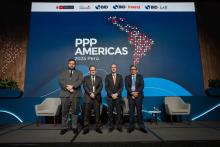In northern Mexico, shaken by drug violence, a family business consolidates one of the largest livestock centers in the world.
Jesús Vizcarra Calderón looks like a character taken from the golden age of Mexican cinema: broad back, inflated chest, thick mustache and the attitude of a friendly cowboy who would not hesitate to come to blows if necessary. But we must be wary of appearances, Jesús Vizcarra Calderón belongs to a very different type of golden age: that of Mexico's livestock industry. Indeed, the flagship company of his empire, SuKarne, processes more than a third of the meat consumed in Mexican homes and 73% of what is exported, according to data from the Ministry of Agriculture, Livestock, Development. Rural, Fishing and Food (Sagarpa). In numbers, that means sales of $2.6 billion in 2014.
And this is just the beginning.
The Vizcarra Calderón family company will inaugurate the Lucero Agroindustrial complex this year (2015). With an investment of more than US$ 600 million, it will have the capacity to house 250,000 heads of cattle for fattening and slaughter and process 800,000 a year – 2,400 a day –, of which 60% to 70% will be destined for export. . All in the municipality of Tlahualilo, Durango. Something notable in a country that, until a decade ago, was not a protagonist in the global livestock industry.
The pearl of the empire. The new complex, located in a 475-hectare industrial estate, will have nine platforms in accordance with the company's basic philosophy: integrate all processes and seek the least waste: the company buys and fattens the cattle, processes and markets absolutely everything. (bones, blood, skin). These include the one that wants to become the largest feedlot in the world, a livestock feed plant that can produce up to 130 tons per hour and the most modern slaughterhouse or slaughterhouse in the country. Even livestock manure will be used on one of the platforms to produce organic fertilizers.
According to data from the Ministry of Economy, the direct economic impact of this agro-industrial initiative will be equivalent to 80% of the agricultural GDP of the state of Durango, and will make it – being the poorest in northern Mexico – one of the protagonists of the meat industry. The 12,500 jobs, both direct and indirect, will be good for Durango, in addition to the benefit to 39,000 agricultural and livestock producers in the region, explains Carlos Ibarra Félix, director of purchasing and intergovernmental relations of the company and in charge of the construction of the project. “The industrial park – he continues – is located in one of the regions most affected by drug violence in the state and in the country” explains Ibarra “But the violence rates are decreasing. The partial start of operation of some of the business units of the agro-industrial park and the benefits it is beginning to generate seem to be positively affecting the population.”
Beef tacos, SuKarne . The Lucero agropark is just one of the company's six production units located in the north of the country: Culiacán, Mexicali, Monterrey, Michoacán, and one outside the country, in Nicaragua. The company led by Jesús Vizcarra Calderón is the fifth largest supplier of beef in North America and the third largest cattle fattener in the world. Its comprehensive model for livestock supply and meat production, including processing and distribution, is “unique in the world,” according to an executive from one of the largest companies in the sector in the world, the Brazilian multinational Marfrig Group.
Annually the company processes 1,300,000 heads of cattle and markets 478,000 tons of beef, pork and chicken; and exports 30% of its production to ten countries on four continents, including the United States (80% of exports), Japan, Hong Kong, South Korea, Italy and Russia. In 2014 Sukarne entered the markets of Chile and Canada, two of the most interesting markets on the continent, and is about to enter China, where its plant in Michoacán obtained validation from the Chinese government a few months ago.
With the construction of the Lucero complex, SuKarne continues with an internationalization plan that aims, in the short term, to export at least 50% of what it produces, explains Ibarra. For these reasons, the company recently received the 2014 National Export Award from the Mexican president, Enrique Peña Nieto.
The company employs more than 10,000 people directly, but its importance in some regions is not only due to the business's own activities. There is an indirect effect of these units on other sectors of the economy in the states where it is located. The company has more than 35,000 livestock suppliers and 50,000 agricultural suppliers and has a commercial network of more than 40,000 points of sale.
The implementation of the Contract Agriculture program by the company, to encourage the production of yellow corn, has managed to replace imports of this product in many regions. Sukarne imported 90% of the yellow corn that he uses to feed his livestock. Now, “the percentage of what we import is decreasing thanks to this program that offers certainty and efficiency to farmers,” explains Ibarra. “With contract farming,” explains Enrique Martínez y Martínez, secretary of Sagarpa, “the pressure on white corn is lowered, imports are reduced and it gives balance to other products such as beans, in addition to the support given to farmers. peasants as part of the productive reconversion.”
Thus, the family business that turned 45 last year is turning Mexico into one of the most important countries globally in the livestock industry, where it is already eighth, behind Paraguay.
“I have never been more impressed with the vision and innovative mentality of a company like SuKarne, even above many companies operating in the United States,” said Daniel K. Berman, Minister of Agriculture of the Department of Agriculture of the United States (USDA), from the US Embassy a few days ago to the newspaper Milenio.
Political past. But how did SuKarne go from calf to bull? Jesús Vizcarra Calderón was born and raised among cows, steers and bulls in the markets of Culiacán, Sinaloa. His father, José Isabel Vizcarra, started the livestock business in 1966 by raising pigs. Three years later, he ventured into cattle fattening. At the age of 7, explains Jesús Vizcarra himself, he perfectly understood his father's business: "buy cheap, fatten the animal and then sell."
The businessman is the oldest of 10 siblings. He was forged and hardened in the family business at an early age. When he was barely 14 years old, in 1974, he had to overcome a livestock crisis in Sinaloa alongside his father. Given the shortage of raw materials, the government authorized the entry of heads from other states. Thus, the young Vizcarra and his father undertook a trip throughout the north of the republic to buy and transport livestock. The boy's courage and knowledge surprised many ranchers in the region, but also his father who, in 1980, when his son was barely 20 years old, gave him the general management of the company.
At the age of 20, Don Chuy, as he is called in his region, began to occupy the business leadership of local, state and national organizations in the agri-food sector. In 1985 he was appointed President of the Board of Directors, a position he holds today. During those years he was mayor, federal deputy, secretary of economic development of his state, national advisor of the PRI, president of the National Federation of Municipalities and PRI candidate for governor of Sinaloa.
The upward trajectory came to an abrupt halt in 2011, when Vizcarra lost the election for the governorship of his state because of an image. It was a photograph next to Mayo Zambada, one of the main drug traffickers of the Sinaloa cartel, taken twenty years before, which ruined an election that seemed to have been won. The businessman agreed to be the one in the photograph, and although Sinaloa is a state in which it is practically impossible to escape contact, even superficial, with one of these characters, the framing cut short his political future.
But Vizcarra has a tough skin: he has always had to face complaints and confrontations with regional power groups. However, SuKarne has never stopped growing and not only in livestock. There is another very productive family business: 60,000 hectares of land where cotton, wheat, corn and fodder are produced for export. “It is the best organized agroindustrial organization with a cooperative of 1,500 members,” he explains.
Expanding market. The livestock stock in Mexico ranges between 32 to 33 million heads of cattle, according to Sagarpa; It is lower than countries like Brazil, Australia and Argentina, but in recent years it is beginning to approach the latter (51 million), which has a very long tradition in the meat industry. In less than a decade, Mexico increased its meat exports seven times, going from 17,528 tons to 141,634 tons in 2013.
''In the framework of the First Regional Livestock Council held in the state of Durango at the beginning of December, it was announced that the balance of the country's Livestock Sector recorded positive and encouraging figures with an annual growth of 9.5% and specifically in beef or beef, a growth of 30% in 2014. This represents a production value of US$ 1.6 billion.
Furthermore, the per capita consumption of meat (beef, pork, poultry, sheep and goats) in Mexico is 63 kilograms annually, when in 1990 it was 34, and in 1970 it was 23 kilograms according to Sagarpa statistics. In the last two decades, Mexico registered an increase of 84.5%, something like 29 kilos of meat consumption per person. It is interesting to note that the world average is 42.9 kilos, while in developing countries it reaches 33.5 and in developed countries it is 76.1 (according to FAO figures)
In this framework, with a portfolio of more than 250 products, and a growing internal and external market that is poorly satisfied by its competition, Vizcarra Calderón's company seems to be in an enviable position for the near future.
Mexico has the possibility of increasing meat production by 200 or 300% in the next 15 years,” announced Jesús Vizcarra when he received the 2014 National Agri-Food Award, last December. And there will surely be mouths to consume it: it is estimated that the global demand for foods of animal origin will be, in 2025, some 60 million tons greater than today.










